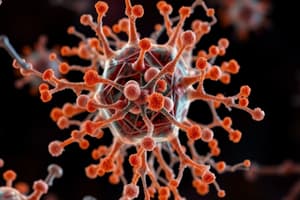Podcast
Questions and Answers
Which type of bond is NOT correctly paired with the class of biomolecule in which it is primarily found?
Which type of bond is NOT correctly paired with the class of biomolecule in which it is primarily found?
- Hydrogen bond – Nucleic acids (correct)
- Glycosidic linkage – Carbohydrates
- Peptide bond – Proteins
- Ester linkage – Lipids
The sequence of amino acids determines the primary structure of a protein.
The sequence of amino acids determines the primary structure of a protein.
True (A)
What are the three components of the cell theory?
What are the three components of the cell theory?
All living organisms are composed of one or more cells; the cell is the basic unit of structure and organization in organisms; cells arise from pre-existing cells.
The process by which monomers are linked together to form polymers is called a ______ reaction, which involves the removal of a water molecule.
The process by which monomers are linked together to form polymers is called a ______ reaction, which involves the removal of a water molecule.
Which of the following is NOT a component of the cytoskeleton?
Which of the following is NOT a component of the cytoskeleton?
Prokaryotic cells contain membrane-bound organelles.
Prokaryotic cells contain membrane-bound organelles.
What is the significance of the extracellular matrix (ECM) in animal cells?
What is the significance of the extracellular matrix (ECM) in animal cells?
According to the endosymbiont theory, ______ and chloroplasts originated from prokaryotic cells that were engulfed by a host cell.
According to the endosymbiont theory, ______ and chloroplasts originated from prokaryotic cells that were engulfed by a host cell.
Which of the following is a key difference between DNA and RNA?
Which of the following is a key difference between DNA and RNA?
Flashcards
Macromolecules
Macromolecules
Large polymers built from small subunit monomers.
Dehydration Reaction
Dehydration Reaction
Reaction that builds polymers by removing a water molecule.
Hydrolysis
Hydrolysis
Reaction that breaks down polymers by adding a water molecule.
Carbohydrate Monomer/Polymer
Carbohydrate Monomer/Polymer
Signup and view all the flashcards
Lipid Monomer/Polymer
Lipid Monomer/Polymer
Signup and view all the flashcards
Protein Monomer/Polymer
Protein Monomer/Polymer
Signup and view all the flashcards
Nucleic Acid Monomer/Polymer
Nucleic Acid Monomer/Polymer
Signup and view all the flashcards
Primary Structure
Primary Structure
Signup and view all the flashcards
Cell Theory
Cell Theory
Signup and view all the flashcards
Prokaryotic vs. Eukaryotic
Prokaryotic vs. Eukaryotic
Signup and view all the flashcards
Study Notes
- Chapter 5 focuses on the structure and function of large biological molecules (biomolecules).
- Chapter 6 tours the cell.
Macromolecules
- Macromolecules are large polymers.
- They are assembled from smaller subunits known as monomers.
Polymer Formation and Breakdown
- Polymers are built through dehydration reactions, which remove a water molecule.
- Polymers are disassembled by hydrolysis, which adds a water molecule.
Major Biomolecule Classes
- The major classes of biomolecules include: carbohydrates, lipids, proteins, and nucleic acids.
Carbohydrates
- A glycosidic linkage is the bond formed in carbohydrates.
Lipids
- An ester linkage is the bond formed in lipids.
Proteins
- A peptide bond is the bond formed in proteins.
- Amino acids can be nonpolar, polar, acidic, or basic, depending on their side chains.
- Protein structures have four levels: primary, secondary, tertiary, and quaternary.
- Denaturation can occur in proteins under certain conditions.
Nucleic Acids
- A phosphodiester bond is the bond in nucleic acids.
- Nucleotides have purine and pyrimidine bases.
- RNA and DNA molecules differ in structure and function.
Cell Theory
- Cell theory serves as a central principle in biology.
Cell Structures
- Prokaryotic and eukaryotic cells differ in structure.
- Eukaryotic cells contain membrane-bound organelles with specific functions.
Endosymbiont Theory
- The endosymbiont theory explains the origin of mitochondria and chloroplasts in eukaryotic cells.
Cytoskeleton
- The cytoskeleton is composed of various components.
- These components have key roles in cell structure and function.
The Extracellular Matrix
- The extracellular matrix is a key component for animal cells.
Plant vs Animal Cells
- Plant and animal cells have key differences.
Studying That Suits You
Use AI to generate personalized quizzes and flashcards to suit your learning preferences.




